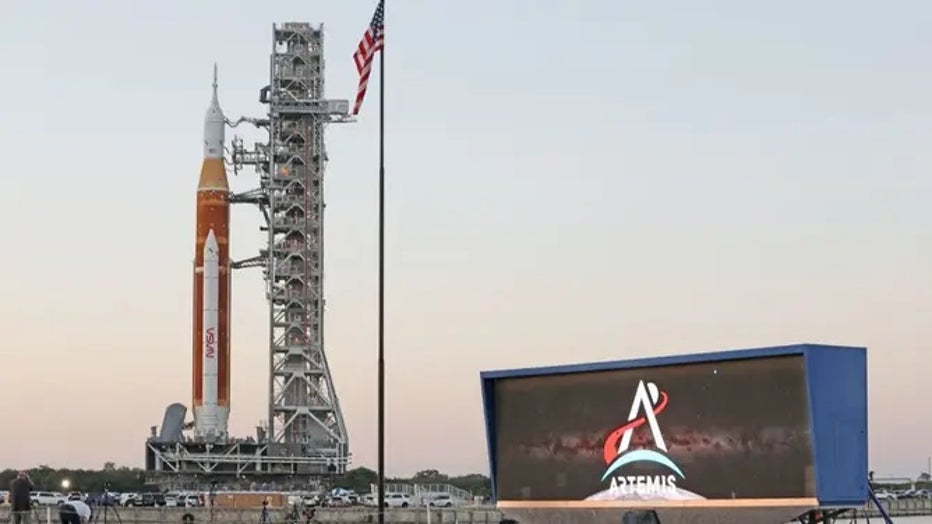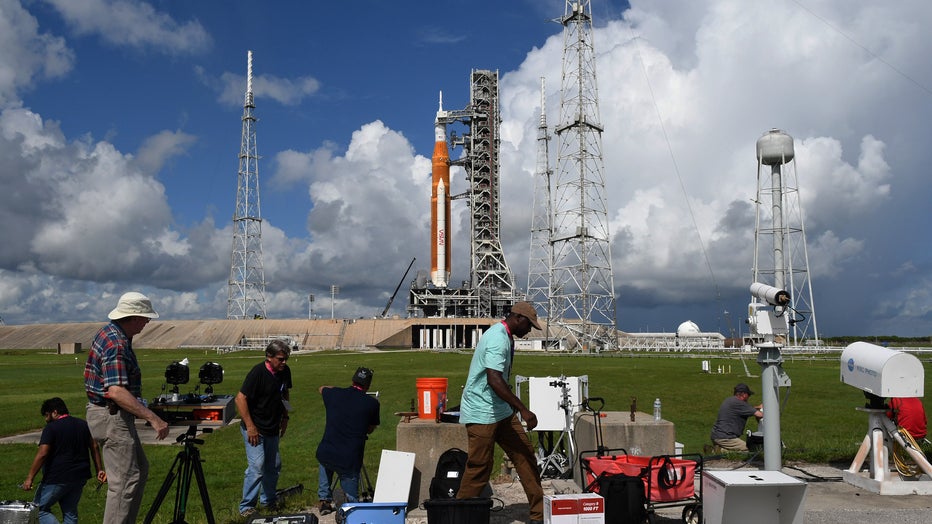Artemis-1 launch: Key milestones to track before liftoff

NASA said that the agency is "go" for next week's launch of the Artemis I mission. The agency said Monday that the Flight Readiness Review has concluded. Its teams are proceeding toward a two-hour launch window starting at 8:33 a.m. ET on Aug. 29 at Florida's Kennedy Space Center. Artemis I marks the first integrated test of NASA’s Orion spacecraft, Space Launch System (SLS) rocket and the ground systems.
KENNEDY SPACE CENTER, Fla. - NASA plans to launch the first rocket in 50 years designed to carry humans back to the moon on Monday. Understanding what happens before the scheduled Artemis launch can help you check off milestones with NASA officials.
NASA's Space Launch System and Orion are set to launch from Kennedy Space Center launchpad 39B no earlier than 8:33 a.m. on August 29.
Onsite at the Kennedy Space Center, the iconic countdown clock is one of the most-watched timepieces.

The massive Artemis I rocket rolls past the countdown clock atop a mobile launch platform en route to Launch Pad 39B from the Vehicle Assembly Building at the Kennedy Space Center in Florida March 17, 2022. (Photo by Gregg Newton / AFP) (Photo by GRE
But, if you're following from home, understanding how the countdown operates and what key events will make you feel just as included as Artemis prepares to launch.
HOW TO WATCH THE ARTEMIS 1 LAUNCH ONLINE AND ON FLORIDA'S SPACE COAST
The Artemis launch countdown contains "L Minus" and "T Minus" times. "L minus" indicates how far away we are from liftoff in hours and minutes. "T minus" time is a sequence of events that are built into the launch countdown. Pauses in the countdown, or "holds," are scheduled into the countdown to allow the launch team to target a precise launch window and to provide a cushion of time for specific tasks and procedures without impacting the overall schedule.
Critical checkpoints for a successful launch
Here are some of the critical events that take place at each milestone after the countdown begins:
L-46 hours 40 minutes and counting
- The launch team arrives at their stations, and the countdown begins. The launch director performs the traditional call to stations, and the countdown clock is activated.
L-32 hours and counting
- Charge both the Orion Flight Batteries and core stage Flight Batteries.
- The SPS Interim Cryogenic Propulsion Stage (ICPS) is powered up for launch. The ICPS is a 45-foot tall single-engine liquid hydrogen/liquid oxygen-based system that will give Orion the big push to fly beyond the moon before the spacecraft returns to Earth.
L-15 hours and counting
- All non-essential personnel leave Kennedy Space Center Launch Complex 39B
L-9 hours, 40 minutes and counting
- Built-in countdown hold begins.
- The launch team conducts a weather and tanking briefing. The launch team will decide if they are a "go" or "no-go" to begin fueling the rocket.
L-8 hours and counting
- NASA begins filling the external tank with liquid oxygen, and hydrogen gets underway.
L-5 hours and counting
- The tank continues to be filled, and a leak test is performed.
L-3 hours and counting
- ICPS/Space Launch System (SLS) telemetry data verified with Mission Control and SLS Engineering Support Center
- Another leak test is performed, and the liquid oxygen is topped off.
L-50 minutes and counting
- The final launch director briefing is held
L-40 minutes and holding
- Built-in 30-minute countdown hold begins
L-15 minutes and holding
- The launch director asks the team to ensure they are "go" for the launch
T-10 minutes and counting
A lot happens in the final 10 minutes before liftoff.
- Ground Launch Sequencer (GLS) initiates terminal count (T-10M)
- Core Stage auxiliary power unit starts (T-4M)
- ICPS enters terminal countdown mode (T-1M20S)
- GLS sends "Go for automated launch sequencer" command (T-33S)
- Hydrogen burn-off igniters initiated (T-12S)
- GLS sends the command for core stage engine start (T-10S)
- RS-25 engines startup (T-6.36S)
T-0
- Booster ignition, umbilical separation, and liftoff. Using four Rs-25 rocket engines and two solid rocket boosters, the SLS will blast off with 8.8 million pounds of thrust.
About the Artemis-1 launch

Photographers set remote cameras as NASAâs Artemis 1 rocket stands ready for launch on pad 39-B at the Kennedy Space Center on August 25, 2022, in Cape Canaveral, Florida. (Photo by Paul Hennessy/Anadolu Agency via Getty Images)
The Artemis 1 mission is the first test flight of NASA's Space Launch System rocket and the Orion spacecraft.
Artemis refers to the name of NASA's campaign to return humans to the moon's surface by 2025 as a jumping-off point to Mars. The four astronauts who launched on that mission, Artemis-3, will be the first moonwalkers since Apollo 17 in 1972.
WHAT IS NASA'S ARTEMIS 1 MISSION GOING TO DO?
There are many goals of this test flight, including testing Orion's communication, navigation and guidance systems, ensuring the overall launch and performance of SLS and ensuring Orion's heat shield can withstand Earth re-entry at 25,000 mph.

